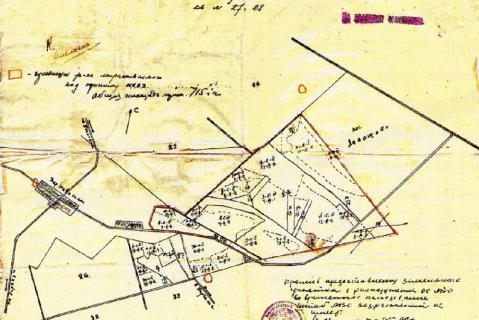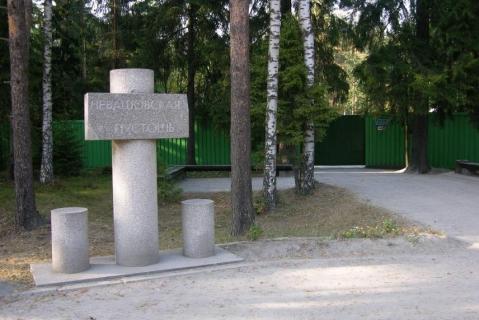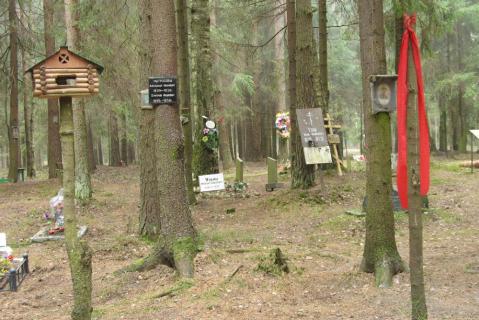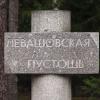From September 1937 to 1954, the area next to the Levashovo rail station (now within St Petersburg city limits) was used for the burial of those who died or were shot in the prisons of Leningrad. In 1937 the territory was fenced off and carefully guarded. It remained under the control of the Leningrad Region KGB until 1990.
The burials were found in spring 1989 by the search group of the Leningrad Memorial society led by V.T. Muravsky. On 18 July 1989 a decree of the Leningrad city soviet executive committee declared that the Levashovo Wasteland would be a memorial cemetery to the victims of political repression and undertook to clear and tidy the site. In 1989 and 1990 the Surveying and Engineering Trust (GRII) and a group from the geological research institute (VNIGRI) carried out an investigation of the area but the results were not published.
Subsidence in the soil over the burial pits and trenches, which has still not been levelled, indicate the location of the burials. Evidence from the archive of the St Petersburg and Leningrad Region FSB suggests that 19,540 people were buried here, including about 8,000 during the Great Terror. For the most part the names of the victims are unknown. Lists of citizens shot in Leningrad after conviction by extra-judicial bodies (troika, etc) were published between 1990 and 1998 in the Vecherny Peterburg newspaper and in the many volumes of the Leningrad Martyrology (1995 onwards) Books of Remembrance.
Relatives and family of those who were shot during the years of terror began to tidy and care for the burial area in spring 1989 and they continue this work to the present. As of 2017 more than 1,300 personal memorials and gravestones had been placed there, all of which have a symbolic location. One of the first collective monuments was added by Memorial in July 1989. More than 20 memorials have been installed by various public organisations and national societies. In June 1993 a belltower was erected due to the efforts of the St Petersburg Association for the Victims of Unjust Repression. In 1996 the mayor of St Petersburg instructed that the monument of “the Moloch of Totalitarianism” be installed opposite the entrance to the cemetery.
The Leningrad Martyrology, 1937-1938: A Book in Remembrance of the Victims of Political Repression (11 vols. 1995-2011) included biographical entries on 37,500 who were shot or sent to the camps.
The Memorial database (2025) draws on the Martyrology and adds 6,281 individuals from St Petersburg Memorial: it lists 53,831 victims in the Leningrad Region.
The Martyrology names 46,382 who were shot, almost all during the Great Terror (46,257). This includes many of those sent to the camps in the early 1930s or then deported to special settlements (but see Memorial figures below). Cases against 276 other individuals were closed; 18 died in custody. 2,497 were earlier sentenced to 5-10 years in the camps: 2,087 of them were shot in 1937-8. Of families and individuals (total 1,073) previously deported from the Region, 999 were shot in 1937-8.
St Petersburg Memorial adds to all these categories and provides a different perspective. It lists a further 997 who were shot, most in 1937-8 (885). Cases against 115 other individuals were closed; 14 of them died in custody. More than 4,000 were sent to the camps: 408 of them were shot later (almost all in 1937-8). Of the families and individuals (total 577) previously deported from the Region, 68 were shot later (almost all in 1937-8).
Adding the two sources together (see 9 January cemetery): 401 prisoners died in captivity, many of them already sentenced to death (242).
| Date | Nature of ceremonies | Organiser or responsible person | Participants | Frequency |
|---|---|---|---|---|
|
25 January
|
Feast of Russia’s New Martyrs and Confessors
|
Russian Orthodox Church (the Metropolitan of St Petersburg)
|
nk
|
Annual event
|
|
June
|
Solemn ceremonies in Remembrance of Victims of Political Repression
|
district councils within the city, St Petersburg Memorial Society
|
nk
|
Annual event
|
|
30 October
|
Remembrance Day for the Victims of Political Repression
|
St Petersburg Memorial Society and other NGOs
|
NGOs, city officials, diplomats, foreign delegations, ethno-confessional groups, relatives & descendants of the victims
|
Annual event
|
|
nk
|
Commemorative Services
|
nk
|
nk
|
From time to time
|
| State of burials | Area | Boundaries |
|---|---|---|
|
subsidence over burial pits and trenches; many grave-markers have survived in varied condition of preservation
|
11.5 hectares, of which the burials occupy 6.5 hectares
|
territory is surrounded by a wooden ́́fence
|
[ original texts and hyperlinks ]
Memorial Research & Information Centre archive (St Petersburg)
“The Levashovo memorial cemetery, pages from history”, Their Names Restored website
St Petersburg Administration website (text of Order 10-605, 22 December 2015)
“The Levashovo memorial cemetery”, Virtual Museum of the Gulag [retrieved, 7 June 2022; no longer accessible]




